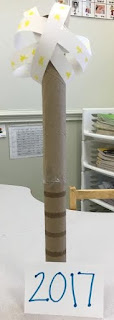Hello
everyone! I am back to write about my recently uploaded January STEAM
Activities resource. The STEAM Activities have been a HUGE
hit in my classroom, so I cannot wait to continue them for the rest of
the year!! The January STEAM Activities set also comes with five
activities. I again tried to incorporate every letter of STEAM's
acronym (science, technology, engineering, art and math) throughout the
month's activities.
Click here to find the link to the product.
The first activity in my January STEAM pack is Times Square Ball drop replica for New Years Eve.
In
this activity, students will use toilet paper rolls or paper towel rolls to build the tower part of the Times Square Ball. They will then use 1/2 of a 12x18 piece of construction (cut long ways) to make the sphere. The construction paper will be cut into thin rectangles and taped together to be a sphere. Students can decorate the ball (even with glitter if you're brave!) and the index card to show the upcoming year.
There is a graphic organizer included to help students plan and improve their creations!
There is a graphic organizer included to help students plan and improve their creations!
To make Martin Luther King Jr.'s podium, students will use 24 Popsicle sticks, a jar of play-doh, tape and a 3 inch x 3 inch piece of card board. Included is also a MLK figurine so students can stand him up behind the podium.
Before completing the activity, you can review who MLK Jr. is by reading the informational sheet included.
During
this activity, students will use campfire marshmallows and tooth picks to build an igloo. To teach more facts about igloos, teachers can read the "What is an igloo?" page. This can be a tricky task, so there are differentiated options such as gluing marshmallows to a toilet paper roll instead. After the students build their igloo, they can place the given Inuit figurines in and/or around their igloo.
Students will use a coffee filter, shades of blue markers and a spray bottle to create a sun catcher Snowflake to hang in the class windows. Before beginning the project I inform students that every single snowflake is different!
The final activity in the January STEAM Activities is the Google Classroom and Lego lesson.
Students
will start on Google classroom. They will move the colored Lego pieces
from the left side of the screen to the puzzle on the right side of the
screen. This will help them build January winter images: a winter hat, a snow boot, a shovel and a hot chocolate mug!
While
the students are completing the Google Classroom lesson, they can color
the graphic organizer to then visualize what each winter item should
look like.
Finally,
they can use the graphic organizer to build with real Legos! The
Google and graphic organizer are a great way for students to plan what
to build!
Thank
you so much for stopping by! I hope these January STEAM Activities
make Science class extra fun for you and your students! Enjoy!





















































